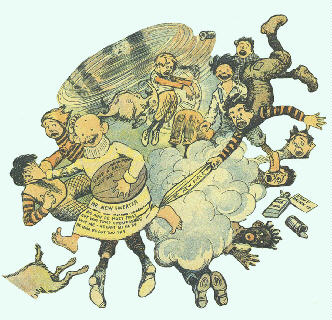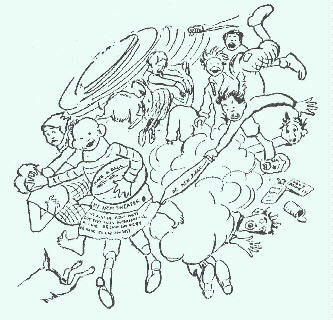The R. F. Outcault Reader - vol. 7
no. 3
The Yellow Kid in McFadden's Flats
Richard D. Olson
On 3 March 1897, an ad appeared in the classified section of The
New
York Journal advertising a new book, The Yellow Kid in
McFadden's
Flats.
| The Ad
--The ad appeared several times in March 1897
--The ad art was a reprinted Yellow Kid figure from the
newspaper sheet music
--The ad was one column wide and three inches tall.
--The ad was published by The New York Journal
|
|
The Book
--The book was published in March, 1897
--The book reprinted art from Sunday comics of the past
six months
--The book was 5 1/2" wide and 7 1/2" tall
--The book was published G. W. Dillingham Co.
|
 The Yellow Kid in McFadden's Flats was
written by E. W.
Townsend, author of "Chimmie Fadden," and illustrated by R. F.
Outcault,
originator of the Yellow Kid. This was the same team that produced the
full-page
Sunday panels every Sunday in the New York Journal. The book was
published
as a 192-page paperback, and was No. 24 in Billingham's American
Authors
Library. It generally featured a page of text on the left page and an
illustration on the right page, and except for being larger, had an
appearance
similar to a Big Little Book. It sold for 50 cents! Today it is
acknowledged
to be the first comic book based on the fact that it contained a
collection
of Sunday reprints. In fact, the only original art in the entire book
was
on the cover (see page 3) and next to the title page (see page 4)! To
document
this fact and increase the validity of identifying this book as the
first
American comic book. Table 1 at the end of this newsletter lists each
illustration in the book by page number and identifies the date of the
Sunday
newspaper comic book where the art was originally published.
The Yellow Kid in McFadden's Flats was
written by E. W.
Townsend, author of "Chimmie Fadden," and illustrated by R. F.
Outcault,
originator of the Yellow Kid. This was the same team that produced the
full-page
Sunday panels every Sunday in the New York Journal. The book was
published
as a 192-page paperback, and was No. 24 in Billingham's American
Authors
Library. It generally featured a page of text on the left page and an
illustration on the right page, and except for being larger, had an
appearance
similar to a Big Little Book. It sold for 50 cents! Today it is
acknowledged
to be the first comic book based on the fact that it contained a
collection
of Sunday reprints. In fact, the only original art in the entire book
was
on the cover (see page 3) and next to the title page (see page 4)! To
document
this fact and increase the validity of identifying this book as the
first
American comic book. Table 1 at the end of this newsletter lists each
illustration in the book by page number and identifies the date of the
Sunday
newspaper comic book where the art was originally published.
The art in the book has been the subject of some recent
controversy. In
his introduction for the book reprinting his collection of Yellow Kid
pages,
Bill Blackbeard (1995, page 129) wrote "The panels from the Humorist
appear
much as they did originally. Unfortunately, most were redrawn,
faithfully
if somewhat crudely, by a hand other than Outcault's (probably because
the
original art had already been destroyed). Engraving plates from the
printed
episodes would have necessitated eliminating the color, too costly a
process
for a one-shot title in a series." And yet, I believe that may be
exactly
what happened! Anyone taking the time to carefully compare the art in
the
Sunday pages with the art in the book will see that the art is
identical
and that the book does not contain a redrawn version of that found in
the
Sunday pages. Admittedly, the art in the book has eliminated all color
and,
thus, some of the details found in the Sunday pages. However if one
compares
the outline of the characters in the Sunday pages and the book and the
layout
of each panel, it becomes clear that they are physically identical!
They
are not similar as they might have been if an artist had carefully
redrawn
each panel, they are identical. This means that some mechanical means
was
used to translate the Sunday art into the images appearing in the book.
Figure
1 at the bottom of this page is a section of the Sunday page dated 15
November
1896. Figure 2 at the bottom of this page is the art reproduced from
the
book on page 64. Compare them for yourself! The color is missing from
Figure
2, and with it, some of the details like the stripes on some of the
boys'
shirts. However, if you coincident with the shapes in Figure 1. Such
physical
perfection does not occur when an artist redraws a scene; rather, it
occurs
when a mechanical means is used to reproduce a scene. The same
relationship
between outlines of the characters holds for all of the art in the book
--
thus, none of it was redrawn! It was simply reproduced without color or
detail,
probably to hold the costs down.
This is a vary rare book. I can identify seven, and possibly
eight, copies.
Given that there must be a few copies I am not aware of, I would guess
that
about a dozen volumes currently exist. Fortunately, it is not a
wonderful
book. It has great historical significance, but it doesn't have great
stories
or art!

Fig. 1

Fig. 2
[ previous page
|
next page ]
[ pages: 1 | 2 | 3
| 4 | 5 |
6 | 7 ]
Richard D. Olson, Ph.D., 40
Infinity Drive, Poplarville,
MS 39470-9006
(769) 717-4077
redoak2002@gmail.com
[ Home | Buy
List | Gallery | History
| Newsletters | Sales List
| Society ]
Web Design and Hosting
by
Fantastic Transcripts
 The Yellow Kid in McFadden's Flats was
written by E. W.
Townsend, author of "Chimmie Fadden," and illustrated by R. F.
Outcault,
originator of the Yellow Kid. This was the same team that produced the
full-page
Sunday panels every Sunday in the New York Journal. The book was
published
as a 192-page paperback, and was No. 24 in Billingham's American
Authors
Library. It generally featured a page of text on the left page and an
illustration on the right page, and except for being larger, had an
appearance
similar to a Big Little Book. It sold for 50 cents! Today it is
acknowledged
to be the first comic book based on the fact that it contained a
collection
of Sunday reprints. In fact, the only original art in the entire book
was
on the cover (see page 3) and next to the title page (see page 4)! To
document
this fact and increase the validity of identifying this book as the
first
American comic book. Table 1 at the end of this newsletter lists each
illustration in the book by page number and identifies the date of the
Sunday
newspaper comic book where the art was originally published.
The Yellow Kid in McFadden's Flats was
written by E. W.
Townsend, author of "Chimmie Fadden," and illustrated by R. F.
Outcault,
originator of the Yellow Kid. This was the same team that produced the
full-page
Sunday panels every Sunday in the New York Journal. The book was
published
as a 192-page paperback, and was No. 24 in Billingham's American
Authors
Library. It generally featured a page of text on the left page and an
illustration on the right page, and except for being larger, had an
appearance
similar to a Big Little Book. It sold for 50 cents! Today it is
acknowledged
to be the first comic book based on the fact that it contained a
collection
of Sunday reprints. In fact, the only original art in the entire book
was
on the cover (see page 3) and next to the title page (see page 4)! To
document
this fact and increase the validity of identifying this book as the
first
American comic book. Table 1 at the end of this newsletter lists each
illustration in the book by page number and identifies the date of the
Sunday
newspaper comic book where the art was originally published.

